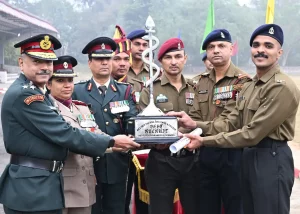Prime Minister Narendra Modi has laid the foundation stone for the Ken-Betwa river-linking project, aimed at addressing the severe water scarcity issues in the Bundelkhand region. The project, which will channel excess water from the Ken River in Madhya Pradesh to the Betwa, promises to improve water access for millions.
PM Modi Launches Ken-Betwa River-Linking Project
Why In News
- Prime Minister Narendra Modi has laid the foundation stone for the Ken-Betwa river-linking project, aimed at addressing the severe water scarcity issues in the Bundelkhand region. The project, which will channel excess water from the Ken River in Madhya Pradesh to the Betwa, promises to improve water access for millions.
- It is expected to benefit around 4.4 million people in 12 districts of Madhya Pradesh and 2.1 million in 10 districts of Uttar Pradesh, providing drinking water and boosting agricultural irrigation. With an estimated cost of ₹44,605 crore, the project will also generate hydropower and solar energy, improving the region’s overall development.
Ken & Betwa Rivers
- Ken River is one of the major rivers in the Bundelkhand region of central India and flows through the states of Madhya Pradesh and Uttar Pradesh. It is a tributary of the Yamuna.
- Betwa is a river in Central and Northern India, and a tributary of the Yamuna. It rises in the Vindhya Range just north of Hoshangabad in Madhya Pradesh and flows northeast through Madhya Pradesh and enters Uttar Pradesh after flowing through Orchha.
Ken-Betwa Project
- Ken-Betwa project was first envisioned following a feasibility study by the National Water Development Authority (NWDA) in 1995, with a cost estimation of ₹1998.74 crore. Over the years, the project has faced numerous delays, with critical agreements and reports completed only after long gaps. In 2023, environmental clearance was granted, allowing work to begin. Modi used the occasion to criticize previous governments, particularly Congress, for failing to address water crises effectively and for delaying crucial infrastructure projects.
- KBLP envisages transferring water from the Ken river to the Betwa river, both tributaries of the Yamuna. The Ken-Betwa Link Canal will be 221 km in length, including a 2-km tunnel. According to the Jal Shakti Ministry, the project is expected to provide annual irrigation to 10.62 lakh hectares (8.11 lakh ha in MP and 2.51 lakh ha in UP) of land, supply drinking water to about 62 lakh people, and generate 103 MW of hydropower and 27 MW of solar power.
- It is the first project under the National Perspective Plan for interlinking of rivers, which was prepared in 1980. This plan has 16 projects under its peninsular component, including the KBLP.
- Apart from this, 14 links are proposed under the Himalayan rivers development plan. Ken-Betwa Link Project has two phases. Phase-I will involve building the Daudhan Dam complex and its subsidiary units such as the Low Level Tunnel, High Level Tunnel, Ken-Betwa Link Canal and power houses. Phase-II will involve three components — Lower Orr Dam, Bina Complex Project and Kotha Barrage.
- The Union Cabinet had approved Rs 44,605 crore (at 2020-21 prices) for the KBLP project in December 2021. PM Modi laid the foundation stone for the Daudhan Dam. Daudhan dam is 2,031 m long, out of which 1,233 metre will be earthen and the rest 798 m will be of concrete. The height of the dam will be 77 m. According to the Jal Shakti Ministry, the dam will submerge about 9,000 hectares of land, affecting 10 villages.
- According to the Jal Shakti Ministry, the KBLP project is proposed to be implemented in eight years.
- On March 22, 2021, a memorandum of agreement was signed among the Ministry of Jal Shakti and the governments of Madhya Pradesh and Uttar Pradesh to implement the Ken-Betwa Link Project.
- The idea of linking the Ken with the Betwa got a major push in August 2005, when a tripartite memorandum of understanding for preparation of a detailed project report (DPR) was signed among the Centre and the two states. In 2008, the Centre declared the KBLP a National Project. Later, it was included as part of the Prime Minister’s package for the development of the drought-prone Bundelkhand region
- In April 2009, it was decided that the DPR would be prepared in two phases. In 2018, a comprehensive DPR, including Phase-I, II and additional area proposed by Madhya Pradesh, was prepared. It was sent to Uttar Pradesh, Madhya Pradesh and the Central Water Commission in October 2018.
- The project lies in Bundelkhand, which spreads across 13 districts of Uttar Pradesh and Madhya Pradesh.
- The river-linking project has faced intense scrutiny for its potential environmental and social impact. The project will involve large-scale deforestation inside the heart of the Panna National Park and Tiger Reserve.
- Also, over the years, experts have sought that hydrological data of Ken’s surplus water be made public for a thorough review or fresh studies. A study published last year by IIT-Bombay scientists even found that moving large quantities of water as part of river linking projects can affect land-atmosphere interplay and feedback and lead to a mean rainfall deficit by up to 12 per cent in September.
























